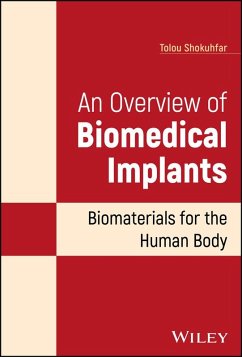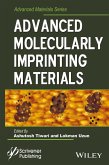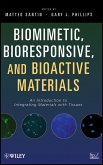159,99 €
159,99 €
inkl. MwSt.
Sofort per Download lieferbar

0 °P sammeln
159,99 €
Als Download kaufen

159,99 €
inkl. MwSt.
Sofort per Download lieferbar

0 °P sammeln
Jetzt verschenken
Alle Infos zum eBook verschenken
159,99 €
inkl. MwSt.
Sofort per Download lieferbar
Alle Infos zum eBook verschenken

0 °P sammeln
- Format: PDF
- Merkliste
- Auf die Merkliste
- Bewerten Bewerten
- Teilen
- Produkt teilen
- Produkterinnerung
- Produkterinnerung

Bitte loggen Sie sich zunächst in Ihr Kundenkonto ein oder registrieren Sie sich bei
bücher.de, um das eBook-Abo tolino select nutzen zu können.
Hier können Sie sich einloggen
Hier können Sie sich einloggen
Sie sind bereits eingeloggt. Klicken Sie auf 2. tolino select Abo, um fortzufahren.

Bitte loggen Sie sich zunächst in Ihr Kundenkonto ein oder registrieren Sie sich bei bücher.de, um das eBook-Abo tolino select nutzen zu können.
Understand the core materials that create biomedical innovation
Some of the greatest medical advances in recent decades have come in the form of biomedical implants. Whether in the form of traditional orthopedic implants, medical devices for the cardiovascular system, or polymer-based ocular implants, biomedical implants can be lifesaving or life-transforming interventions. The biomaterials which comprise these implants are a vital area of ongoing research, but no prior volume has ever taken comprehensive stock of this subject and its growing applications.
An Overview of Biomedical…mehr
- Geräte: PC
- mit Kopierschutz
- eBook Hilfe
- Größe: 9.98MB
Andere Kunden interessierten sich auch für
![Green and Sustainable Advanced Materials, Volume 1 (eBook, PDF) Green and Sustainable Advanced Materials, Volume 1 (eBook, PDF)]() Green and Sustainable Advanced Materials, Volume 1 (eBook, PDF)190,99 €
Green and Sustainable Advanced Materials, Volume 1 (eBook, PDF)190,99 €![Advanced Molecularly Imprinting Materials (eBook, PDF) Advanced Molecularly Imprinting Materials (eBook, PDF)]() Advanced Molecularly Imprinting Materials (eBook, PDF)197,99 €
Advanced Molecularly Imprinting Materials (eBook, PDF)197,99 €![Genetic and Evolutionary Computation (eBook, PDF) Genetic and Evolutionary Computation (eBook, PDF)]() Genetic and Evolutionary Computation (eBook, PDF)107,99 €
Genetic and Evolutionary Computation (eBook, PDF)107,99 €![Handbook of Renewable Materials for Coloration and Finishing (eBook, PDF) Handbook of Renewable Materials for Coloration and Finishing (eBook, PDF)]() Handbook of Renewable Materials for Coloration and Finishing (eBook, PDF)210,99 €
Handbook of Renewable Materials for Coloration and Finishing (eBook, PDF)210,99 €![Biomaterials (eBook, PDF) Biomaterials (eBook, PDF)]() Biomaterials (eBook, PDF)139,99 €
Biomaterials (eBook, PDF)139,99 €![Biomimetics (eBook, PDF) Biomimetics (eBook, PDF)]() Biomimetics (eBook, PDF)181,99 €
Biomimetics (eBook, PDF)181,99 €![Biomimetic, Bioresponsive, and Bioactive Materials (eBook, PDF) Biomimetic, Bioresponsive, and Bioactive Materials (eBook, PDF)]() Biomimetic, Bioresponsive, and Bioactive Materials (eBook, PDF)94,99 €
Biomimetic, Bioresponsive, and Bioactive Materials (eBook, PDF)94,99 €-
-
-
Understand the core materials that create biomedical innovation
Some of the greatest medical advances in recent decades have come in the form of biomedical implants. Whether in the form of traditional orthopedic implants, medical devices for the cardiovascular system, or polymer-based ocular implants, biomedical implants can be lifesaving or life-transforming interventions. The biomaterials which comprise these implants are a vital area of ongoing research, but no prior volume has ever taken comprehensive stock of this subject and its growing applications.
An Overview of Biomedical Implants fills this gap with a thorough overview of all major biomaterials and their role in biomedical implants. Composed for an interdisciplinary audience, the book addresses all scales and areas of application. The result is an essential resource in this critical ongoing area of biomedical research.
An Overview of Biomedical Implants readers will also find:
An Overview of Biomedical Implants is ideal for physicians, scientists, and engineers-those working in the area of biomaterials, medical, biological and chemical and applied physics, pharmaceutical science and as a reference for professors and students in these areas.
Some of the greatest medical advances in recent decades have come in the form of biomedical implants. Whether in the form of traditional orthopedic implants, medical devices for the cardiovascular system, or polymer-based ocular implants, biomedical implants can be lifesaving or life-transforming interventions. The biomaterials which comprise these implants are a vital area of ongoing research, but no prior volume has ever taken comprehensive stock of this subject and its growing applications.
An Overview of Biomedical Implants fills this gap with a thorough overview of all major biomaterials and their role in biomedical implants. Composed for an interdisciplinary audience, the book addresses all scales and areas of application. The result is an essential resource in this critical ongoing area of biomedical research.
An Overview of Biomedical Implants readers will also find:
- Description of the relationship between every specific biomaterial and its role in each major implant category
- Detailed discussion of nanoscale to molecular-scale to industrial-scale biomaterials
- Concrete examples in every chapter, along with a list of pertinent references
An Overview of Biomedical Implants is ideal for physicians, scientists, and engineers-those working in the area of biomaterials, medical, biological and chemical and applied physics, pharmaceutical science and as a reference for professors and students in these areas.
Dieser Download kann aus rechtlichen Gründen nur mit Rechnungsadresse in D ausgeliefert werden.
Produktdetails
- Produktdetails
- Verlag: John Wiley & Sons
- Seitenzahl: 275
- Erscheinungstermin: 24. Januar 2025
- Englisch
- ISBN-13: 9781119850984
- Artikelnr.: 73166917
- Verlag: John Wiley & Sons
- Seitenzahl: 275
- Erscheinungstermin: 24. Januar 2025
- Englisch
- ISBN-13: 9781119850984
- Artikelnr.: 73166917
- Herstellerkennzeichnung Die Herstellerinformationen sind derzeit nicht verfügbar.
Tolou Shokuhfar, PhD, is an Associate Professor of Bioengineering at University of Illinois at Chicago. She is a recipient of an NSF CAREER Award that pioneers the visualization of biomineralization, biological materials, nanomaterial/protein interactions and microorganisms in nanoenclosures. She has also received the SFB Ortho SIG Faculty Abstract award, TMS Young Leaders Award, DSL Young Scientist Award, and "INSIGHT Diversity Award for Inspiring Women in STEM". Dr. Shokuhfar has been the Chair for Orthopedic Biomaterials SIG and Vice Chair of Nanomaterials SIG at the Society for Biomaterials since 2019.
Preface xiii
Acknowledgments xiv
1 Biomaterials for Dental Implants 1
1.1 Introduction: Dental Implants and Current Materials 1
1.1.1 The Need for Better Dental Implants 1
1.1.2 Various Approaches and Biomaterials to Improve Dental Implants 3
1.1.3 Working at the Nanoscale to Improve Dental Implants 6
1.2 Ceramic Dental Implants 8
1.2.1 Zirconia 8
1.2.1.1 Surface Roughness Optimization of Zirconia-Based Implants 9
1.2.1.2 Coating Alternatives for Zirconia-Based Implants 9
1.2.1.3 Using Nanotechnology to Modify Zirconia-Based Implants 10
1.2.1.4 Disadvantages and Advantages of Zirconia-Based Implants 11
1.2.2 Hydroxyapatite 12
1.2.2.1 Antimicrobial Properties of Hydroxyapatite-Containing Materials 12
1.2.2.2 Combination Dental Materials Using Hydroxyapatite 13
1.2.2.3 Nano-Hydroxyapatite 14
1.2.2.4 Disadvantages and Advantages of HA-based Biomaterials 15
1.3 Polyetheretherketone (PEEK) 15
1.3.1 PEEK Composites to Improve Mechanical Properties 16
1.3.2 PEEK Bioactivity 17
1.3.3 Working at the Nanoscale and With Composites to Enhance PEEK
Bioactivity 17
1.3.4 Disadvantages and Advantages of PEEK 20
1.4 Peptide Coatings for Dental Implants 20
1.5 Functionally Graded Dental Implants 22
1.5.1 Biological Responses to Functionally Graded Dental Implants 24
1.5.2 Radially Designed FGMs for Dental Implants 25
1.5.3 Disadvantages and Advantages of FGMs 26
1.6 Looking to the Future: State-of-the-Art Biomaterials for Dental
Implants 26
1.7 Conclusion 28
References 29
2.1 Biomaterials for Total Hip Implants 35
2.1.1 Introduction 35
2.1.2 History of THA Development 36
2.1.3 Metallic Materials 36
2.1.3.1 Stainless Steel 36
2.1.3.2 Cobalt-Chromium Alloys 37
2.1.3.3 Titanium Alloys 37
2.1.3.4 Alloy Surface Modifications 37
2.1.4 Exploited Materials for Bearing Surface 38
2.1.4.1 Polymers 38
2.1.4.1.1 Ultrahigh Molecular Weight Polyethylene (UHMWPE) 38
2.1.4.1.2 High Cross-Linked UHMWPE (XLPE) 38
2.1.4.1.3 Antioxidant-Doped PE 38
2.1.4.1.4 Poly(2-methacryloyloxyethyl phosphorylcholine) (PMPC) 39
2.1.4.2 Ceramics 39
2.1.4.2.1 Alumina 39
2.1.4.2.2 Zirconia 39
2.1.4.2.3 Alumina-Zirconia Composites 40
2.1.4.2.4 Silicon Nitride 40
2.1.4.2.5 Hybrid Design of Oxide Ceramic Layer on Metal (Oxinium(TM)) 40
2.1.4.2.6 Ultra-Hard Coatings on Metals 41
2.1.4.2.7 Clinical Aspects of Bearing Surface 41
2.1.4.3 MoP Articulation 42
2.1.4.3.1 Advantages 42
2.1.4.3.2 Disadvantages 42
2.1.4.3.3 Wear Mechanism 42
2.1.4.4 MoM Articulation 42
2.1.4.4.1 Advantages 42
2.1.4.4.2 Disadvantages 43
2.1.4.4.3 Wear Mechanism 43
2.1.4.5 CoC Articulation 43
2.1.4.5.1 Advantages 43
2.1.4.5.2 Disadvantages 44
2.1.4.5.3 Wear Mechanism 45
2.1.4.6 CoP Articulation 45
2.1.4.6.1 Advantages 45
2.1.4.6.2 Disadvantages 45
2.1.4.6.3 Wear Mechanism 45
2.1.5 Orthopedic Wear Debris 46
2.1.6 Conclusion 47
References 47
2.2 Biomaterials for Total Knee Replacement (TKR) and Total Hip Replacement
(THR) and Next-Generation Advancements 57
2.2.1 Introduction 57
2.2.2 Ultra-High Molecular Weight Polyethylene (UHMWPE) and Polyethylene
(PE) 61
2.2.3 Polyetheretherketone (PEEK) 62
2.2.4 Polymethylmethacrylate (PMMA) 65
2.2.5 Metal Implants 68
2.2.5.1 Metal Implants: Titanium (Ti) Alloys and Cobalt-Chromium (Co-Cr)
and Surface Treatments 68
2.2.5.2 Metal Implants: Stainless Steel and Next Generation Surface
Treatments 71
2.2.5.3 Porous Coatings 73
2.2.6 Ceramics and New Generation Surface Treatments 76
2.2.7 Advancements in Biomedicine and Nanotechnology: Titanium, Silver
Nanoparticles, and More 78
2.2.8 Summary and Conclusion 81
References 83
2.3 Biomaterials for Shoulder Implants 91
2.3.1 Introduction 91
2.3.2 Titanium Alloys 95
2.3.3 Cobalt-Chrome Alloys 95
2.3.4 Ceramics 96
2.3.5 Pyrolytic Carbon 96
2.3.6 Comparison of Shoulder Implants with Different Class Materials 97
2.3.7 Conclusion 97
References 98
3 Biomaterials for Spinal Implants 103
3.1 Introduction 103
3.2 Overview of Implants and Corresponding Material Design Requirements 104
3.2.1 Spinal Cages 104
3.2.2 Spinal Rods 104
3.2.3 Pedicle Screws 105
3.2.4 Plates 105
3.2.5 Disc Replacements 105
3.3 Metals 106
3.3.1 Titanium and its Alloys 106
3.3.2 Stainless Steel 108
3.3.3 Cobalt-Chromium and its Alloys 108
3.3.4 Nitinol 108
3.3.5 Tantalum 109
3.4 Ceramics 109
3.4.1 Silicon Nitride 109
3.5 Polymers 112
3.5.1 Peek 112
3.6 3D-Printed Spinal Implants: Applications and Relevant Materials 118
3.7 Degradable Implants 118
3.8 Discussion 119
3.9 Conclusion 120
References 120
4 Biomaterials in Cochlear Implants 123
4.1 Introduction 123
4.2 Biological Requirements 125
4.3 Electrical Requirements 126
4.4 Mechanical Requirements 126
4.5 New Electrode Biomaterials 127
4.5.1 Dexamethasone (DEX) 127
4.6 Nanoscale Coatings 129
4.7 New Potential Implant Materials 134
4.8 Drug Delivery 135
4.9 Summary and Conclusion 136
References 138
5 Biomaterials for Cardiovascular Implants 141
5.1 Introduction 141
5.2 Different Applications 143
5.2.1 Stents 143
5.2.1.1 Balloon Expandable Stents 144
5.2.1.2 Self-Expandable Stents 146
5.2.1.3 Drug-Eluting Stents 148
5.2.1.4 Biodegradable Stents 150
5.2.1.5 Latest Stent Inventions 152
5.2.2 Prosthetic Heart Valves 153
5.2.2.1 Mechanical Valves 155
5.2.2.2 Bioprosthetic Valves 160
5.2.2.3 Latest Valves Advancements 161
5.3 Summary and Conclusions 162
References 164
6 Biomaterials for Liver and Kidney Implants 173
6.1 Introduction 173
6.2 Liver Biomaterials 175
6.2.1 General View 175
6.2.2 Biomaterials and Structures 177
6.2.2.1 Natural Polymers 178
6.2.2.2 Synthetic Material 179
6.2.2.3 Decellularized Matrix 181
6.2.3 Conventional Therapy and Future 184
6.3 Kidney Biomaterials 186
6.3.1 A General View 186
6.3.2 Biomaterials and Structure 188
6.3.3 Conventional Therapy and Future 190
6.4 Conclusions 193
References 194
7 Biomaterials for Brain Implants 199
7.1 Introduction 199
7.2 Brain Implants Classification 201
7.2.1 Brain Implants for Recording 201
7.2.1.1 Electrocorticography (ECoG) 201
7.2.1.2 Multielectrode Arrays (MEAs) 202
7.2.2 Brain Stimulator Implants 202
7.2.3 Brain Regenerative Medicine 206
7.3 Causes of Failure 207
7.4 Materials for Neural Electrodes 210
7.4.1 Neural Electrodes 210
7.4.2 Materials for Microelectrode Fabrication 211
7.4.2.1 Conductive Polymers 212
7.4.2.2 Carbon Nanotubes 213
7.4.2.3 Graphene 214
7.4.2.4 Hybrid Nanomaterials 216
7.5 Conclusions 217
References 218
8 Biomaterials for Bionic Implants 225
8.1 Introduction 225
8.2 Biomaterials in Bionic Eye and Neural Systems 227
8.2.1 Implant Package 227
8.2.2 Electrodes 229
8.2.2.1 Diamond Electrodes 229
8.2.2.2 Organic Polymer Electrode Coating 233
8.3 Biomaterials in Bionic Limbs 234
8.3.1 Upper Limb 235
8.3.1.1 Electrodes 235
8.3.1.2 Electrode Packaging and Encapsulation 237
8.3.1.3 Arms 238
8.3.2 Lower Limb 239
8.4 Summary Conclusion 241
References 241
9 Final Remarks 249
Index 251
Acknowledgments xiv
1 Biomaterials for Dental Implants 1
1.1 Introduction: Dental Implants and Current Materials 1
1.1.1 The Need for Better Dental Implants 1
1.1.2 Various Approaches and Biomaterials to Improve Dental Implants 3
1.1.3 Working at the Nanoscale to Improve Dental Implants 6
1.2 Ceramic Dental Implants 8
1.2.1 Zirconia 8
1.2.1.1 Surface Roughness Optimization of Zirconia-Based Implants 9
1.2.1.2 Coating Alternatives for Zirconia-Based Implants 9
1.2.1.3 Using Nanotechnology to Modify Zirconia-Based Implants 10
1.2.1.4 Disadvantages and Advantages of Zirconia-Based Implants 11
1.2.2 Hydroxyapatite 12
1.2.2.1 Antimicrobial Properties of Hydroxyapatite-Containing Materials 12
1.2.2.2 Combination Dental Materials Using Hydroxyapatite 13
1.2.2.3 Nano-Hydroxyapatite 14
1.2.2.4 Disadvantages and Advantages of HA-based Biomaterials 15
1.3 Polyetheretherketone (PEEK) 15
1.3.1 PEEK Composites to Improve Mechanical Properties 16
1.3.2 PEEK Bioactivity 17
1.3.3 Working at the Nanoscale and With Composites to Enhance PEEK
Bioactivity 17
1.3.4 Disadvantages and Advantages of PEEK 20
1.4 Peptide Coatings for Dental Implants 20
1.5 Functionally Graded Dental Implants 22
1.5.1 Biological Responses to Functionally Graded Dental Implants 24
1.5.2 Radially Designed FGMs for Dental Implants 25
1.5.3 Disadvantages and Advantages of FGMs 26
1.6 Looking to the Future: State-of-the-Art Biomaterials for Dental
Implants 26
1.7 Conclusion 28
References 29
2.1 Biomaterials for Total Hip Implants 35
2.1.1 Introduction 35
2.1.2 History of THA Development 36
2.1.3 Metallic Materials 36
2.1.3.1 Stainless Steel 36
2.1.3.2 Cobalt-Chromium Alloys 37
2.1.3.3 Titanium Alloys 37
2.1.3.4 Alloy Surface Modifications 37
2.1.4 Exploited Materials for Bearing Surface 38
2.1.4.1 Polymers 38
2.1.4.1.1 Ultrahigh Molecular Weight Polyethylene (UHMWPE) 38
2.1.4.1.2 High Cross-Linked UHMWPE (XLPE) 38
2.1.4.1.3 Antioxidant-Doped PE 38
2.1.4.1.4 Poly(2-methacryloyloxyethyl phosphorylcholine) (PMPC) 39
2.1.4.2 Ceramics 39
2.1.4.2.1 Alumina 39
2.1.4.2.2 Zirconia 39
2.1.4.2.3 Alumina-Zirconia Composites 40
2.1.4.2.4 Silicon Nitride 40
2.1.4.2.5 Hybrid Design of Oxide Ceramic Layer on Metal (Oxinium(TM)) 40
2.1.4.2.6 Ultra-Hard Coatings on Metals 41
2.1.4.2.7 Clinical Aspects of Bearing Surface 41
2.1.4.3 MoP Articulation 42
2.1.4.3.1 Advantages 42
2.1.4.3.2 Disadvantages 42
2.1.4.3.3 Wear Mechanism 42
2.1.4.4 MoM Articulation 42
2.1.4.4.1 Advantages 42
2.1.4.4.2 Disadvantages 43
2.1.4.4.3 Wear Mechanism 43
2.1.4.5 CoC Articulation 43
2.1.4.5.1 Advantages 43
2.1.4.5.2 Disadvantages 44
2.1.4.5.3 Wear Mechanism 45
2.1.4.6 CoP Articulation 45
2.1.4.6.1 Advantages 45
2.1.4.6.2 Disadvantages 45
2.1.4.6.3 Wear Mechanism 45
2.1.5 Orthopedic Wear Debris 46
2.1.6 Conclusion 47
References 47
2.2 Biomaterials for Total Knee Replacement (TKR) and Total Hip Replacement
(THR) and Next-Generation Advancements 57
2.2.1 Introduction 57
2.2.2 Ultra-High Molecular Weight Polyethylene (UHMWPE) and Polyethylene
(PE) 61
2.2.3 Polyetheretherketone (PEEK) 62
2.2.4 Polymethylmethacrylate (PMMA) 65
2.2.5 Metal Implants 68
2.2.5.1 Metal Implants: Titanium (Ti) Alloys and Cobalt-Chromium (Co-Cr)
and Surface Treatments 68
2.2.5.2 Metal Implants: Stainless Steel and Next Generation Surface
Treatments 71
2.2.5.3 Porous Coatings 73
2.2.6 Ceramics and New Generation Surface Treatments 76
2.2.7 Advancements in Biomedicine and Nanotechnology: Titanium, Silver
Nanoparticles, and More 78
2.2.8 Summary and Conclusion 81
References 83
2.3 Biomaterials for Shoulder Implants 91
2.3.1 Introduction 91
2.3.2 Titanium Alloys 95
2.3.3 Cobalt-Chrome Alloys 95
2.3.4 Ceramics 96
2.3.5 Pyrolytic Carbon 96
2.3.6 Comparison of Shoulder Implants with Different Class Materials 97
2.3.7 Conclusion 97
References 98
3 Biomaterials for Spinal Implants 103
3.1 Introduction 103
3.2 Overview of Implants and Corresponding Material Design Requirements 104
3.2.1 Spinal Cages 104
3.2.2 Spinal Rods 104
3.2.3 Pedicle Screws 105
3.2.4 Plates 105
3.2.5 Disc Replacements 105
3.3 Metals 106
3.3.1 Titanium and its Alloys 106
3.3.2 Stainless Steel 108
3.3.3 Cobalt-Chromium and its Alloys 108
3.3.4 Nitinol 108
3.3.5 Tantalum 109
3.4 Ceramics 109
3.4.1 Silicon Nitride 109
3.5 Polymers 112
3.5.1 Peek 112
3.6 3D-Printed Spinal Implants: Applications and Relevant Materials 118
3.7 Degradable Implants 118
3.8 Discussion 119
3.9 Conclusion 120
References 120
4 Biomaterials in Cochlear Implants 123
4.1 Introduction 123
4.2 Biological Requirements 125
4.3 Electrical Requirements 126
4.4 Mechanical Requirements 126
4.5 New Electrode Biomaterials 127
4.5.1 Dexamethasone (DEX) 127
4.6 Nanoscale Coatings 129
4.7 New Potential Implant Materials 134
4.8 Drug Delivery 135
4.9 Summary and Conclusion 136
References 138
5 Biomaterials for Cardiovascular Implants 141
5.1 Introduction 141
5.2 Different Applications 143
5.2.1 Stents 143
5.2.1.1 Balloon Expandable Stents 144
5.2.1.2 Self-Expandable Stents 146
5.2.1.3 Drug-Eluting Stents 148
5.2.1.4 Biodegradable Stents 150
5.2.1.5 Latest Stent Inventions 152
5.2.2 Prosthetic Heart Valves 153
5.2.2.1 Mechanical Valves 155
5.2.2.2 Bioprosthetic Valves 160
5.2.2.3 Latest Valves Advancements 161
5.3 Summary and Conclusions 162
References 164
6 Biomaterials for Liver and Kidney Implants 173
6.1 Introduction 173
6.2 Liver Biomaterials 175
6.2.1 General View 175
6.2.2 Biomaterials and Structures 177
6.2.2.1 Natural Polymers 178
6.2.2.2 Synthetic Material 179
6.2.2.3 Decellularized Matrix 181
6.2.3 Conventional Therapy and Future 184
6.3 Kidney Biomaterials 186
6.3.1 A General View 186
6.3.2 Biomaterials and Structure 188
6.3.3 Conventional Therapy and Future 190
6.4 Conclusions 193
References 194
7 Biomaterials for Brain Implants 199
7.1 Introduction 199
7.2 Brain Implants Classification 201
7.2.1 Brain Implants for Recording 201
7.2.1.1 Electrocorticography (ECoG) 201
7.2.1.2 Multielectrode Arrays (MEAs) 202
7.2.2 Brain Stimulator Implants 202
7.2.3 Brain Regenerative Medicine 206
7.3 Causes of Failure 207
7.4 Materials for Neural Electrodes 210
7.4.1 Neural Electrodes 210
7.4.2 Materials for Microelectrode Fabrication 211
7.4.2.1 Conductive Polymers 212
7.4.2.2 Carbon Nanotubes 213
7.4.2.3 Graphene 214
7.4.2.4 Hybrid Nanomaterials 216
7.5 Conclusions 217
References 218
8 Biomaterials for Bionic Implants 225
8.1 Introduction 225
8.2 Biomaterials in Bionic Eye and Neural Systems 227
8.2.1 Implant Package 227
8.2.2 Electrodes 229
8.2.2.1 Diamond Electrodes 229
8.2.2.2 Organic Polymer Electrode Coating 233
8.3 Biomaterials in Bionic Limbs 234
8.3.1 Upper Limb 235
8.3.1.1 Electrodes 235
8.3.1.2 Electrode Packaging and Encapsulation 237
8.3.1.3 Arms 238
8.3.2 Lower Limb 239
8.4 Summary Conclusion 241
References 241
9 Final Remarks 249
Index 251
Preface xiii
Acknowledgments xiv
1 Biomaterials for Dental Implants 1
1.1 Introduction: Dental Implants and Current Materials 1
1.1.1 The Need for Better Dental Implants 1
1.1.2 Various Approaches and Biomaterials to Improve Dental Implants 3
1.1.3 Working at the Nanoscale to Improve Dental Implants 6
1.2 Ceramic Dental Implants 8
1.2.1 Zirconia 8
1.2.1.1 Surface Roughness Optimization of Zirconia-Based Implants 9
1.2.1.2 Coating Alternatives for Zirconia-Based Implants 9
1.2.1.3 Using Nanotechnology to Modify Zirconia-Based Implants 10
1.2.1.4 Disadvantages and Advantages of Zirconia-Based Implants 11
1.2.2 Hydroxyapatite 12
1.2.2.1 Antimicrobial Properties of Hydroxyapatite-Containing Materials 12
1.2.2.2 Combination Dental Materials Using Hydroxyapatite 13
1.2.2.3 Nano-Hydroxyapatite 14
1.2.2.4 Disadvantages and Advantages of HA-based Biomaterials 15
1.3 Polyetheretherketone (PEEK) 15
1.3.1 PEEK Composites to Improve Mechanical Properties 16
1.3.2 PEEK Bioactivity 17
1.3.3 Working at the Nanoscale and With Composites to Enhance PEEK
Bioactivity 17
1.3.4 Disadvantages and Advantages of PEEK 20
1.4 Peptide Coatings for Dental Implants 20
1.5 Functionally Graded Dental Implants 22
1.5.1 Biological Responses to Functionally Graded Dental Implants 24
1.5.2 Radially Designed FGMs for Dental Implants 25
1.5.3 Disadvantages and Advantages of FGMs 26
1.6 Looking to the Future: State-of-the-Art Biomaterials for Dental
Implants 26
1.7 Conclusion 28
References 29
2.1 Biomaterials for Total Hip Implants 35
2.1.1 Introduction 35
2.1.2 History of THA Development 36
2.1.3 Metallic Materials 36
2.1.3.1 Stainless Steel 36
2.1.3.2 Cobalt-Chromium Alloys 37
2.1.3.3 Titanium Alloys 37
2.1.3.4 Alloy Surface Modifications 37
2.1.4 Exploited Materials for Bearing Surface 38
2.1.4.1 Polymers 38
2.1.4.1.1 Ultrahigh Molecular Weight Polyethylene (UHMWPE) 38
2.1.4.1.2 High Cross-Linked UHMWPE (XLPE) 38
2.1.4.1.3 Antioxidant-Doped PE 38
2.1.4.1.4 Poly(2-methacryloyloxyethyl phosphorylcholine) (PMPC) 39
2.1.4.2 Ceramics 39
2.1.4.2.1 Alumina 39
2.1.4.2.2 Zirconia 39
2.1.4.2.3 Alumina-Zirconia Composites 40
2.1.4.2.4 Silicon Nitride 40
2.1.4.2.5 Hybrid Design of Oxide Ceramic Layer on Metal (Oxinium(TM)) 40
2.1.4.2.6 Ultra-Hard Coatings on Metals 41
2.1.4.2.7 Clinical Aspects of Bearing Surface 41
2.1.4.3 MoP Articulation 42
2.1.4.3.1 Advantages 42
2.1.4.3.2 Disadvantages 42
2.1.4.3.3 Wear Mechanism 42
2.1.4.4 MoM Articulation 42
2.1.4.4.1 Advantages 42
2.1.4.4.2 Disadvantages 43
2.1.4.4.3 Wear Mechanism 43
2.1.4.5 CoC Articulation 43
2.1.4.5.1 Advantages 43
2.1.4.5.2 Disadvantages 44
2.1.4.5.3 Wear Mechanism 45
2.1.4.6 CoP Articulation 45
2.1.4.6.1 Advantages 45
2.1.4.6.2 Disadvantages 45
2.1.4.6.3 Wear Mechanism 45
2.1.5 Orthopedic Wear Debris 46
2.1.6 Conclusion 47
References 47
2.2 Biomaterials for Total Knee Replacement (TKR) and Total Hip Replacement
(THR) and Next-Generation Advancements 57
2.2.1 Introduction 57
2.2.2 Ultra-High Molecular Weight Polyethylene (UHMWPE) and Polyethylene
(PE) 61
2.2.3 Polyetheretherketone (PEEK) 62
2.2.4 Polymethylmethacrylate (PMMA) 65
2.2.5 Metal Implants 68
2.2.5.1 Metal Implants: Titanium (Ti) Alloys and Cobalt-Chromium (Co-Cr)
and Surface Treatments 68
2.2.5.2 Metal Implants: Stainless Steel and Next Generation Surface
Treatments 71
2.2.5.3 Porous Coatings 73
2.2.6 Ceramics and New Generation Surface Treatments 76
2.2.7 Advancements in Biomedicine and Nanotechnology: Titanium, Silver
Nanoparticles, and More 78
2.2.8 Summary and Conclusion 81
References 83
2.3 Biomaterials for Shoulder Implants 91
2.3.1 Introduction 91
2.3.2 Titanium Alloys 95
2.3.3 Cobalt-Chrome Alloys 95
2.3.4 Ceramics 96
2.3.5 Pyrolytic Carbon 96
2.3.6 Comparison of Shoulder Implants with Different Class Materials 97
2.3.7 Conclusion 97
References 98
3 Biomaterials for Spinal Implants 103
3.1 Introduction 103
3.2 Overview of Implants and Corresponding Material Design Requirements 104
3.2.1 Spinal Cages 104
3.2.2 Spinal Rods 104
3.2.3 Pedicle Screws 105
3.2.4 Plates 105
3.2.5 Disc Replacements 105
3.3 Metals 106
3.3.1 Titanium and its Alloys 106
3.3.2 Stainless Steel 108
3.3.3 Cobalt-Chromium and its Alloys 108
3.3.4 Nitinol 108
3.3.5 Tantalum 109
3.4 Ceramics 109
3.4.1 Silicon Nitride 109
3.5 Polymers 112
3.5.1 Peek 112
3.6 3D-Printed Spinal Implants: Applications and Relevant Materials 118
3.7 Degradable Implants 118
3.8 Discussion 119
3.9 Conclusion 120
References 120
4 Biomaterials in Cochlear Implants 123
4.1 Introduction 123
4.2 Biological Requirements 125
4.3 Electrical Requirements 126
4.4 Mechanical Requirements 126
4.5 New Electrode Biomaterials 127
4.5.1 Dexamethasone (DEX) 127
4.6 Nanoscale Coatings 129
4.7 New Potential Implant Materials 134
4.8 Drug Delivery 135
4.9 Summary and Conclusion 136
References 138
5 Biomaterials for Cardiovascular Implants 141
5.1 Introduction 141
5.2 Different Applications 143
5.2.1 Stents 143
5.2.1.1 Balloon Expandable Stents 144
5.2.1.2 Self-Expandable Stents 146
5.2.1.3 Drug-Eluting Stents 148
5.2.1.4 Biodegradable Stents 150
5.2.1.5 Latest Stent Inventions 152
5.2.2 Prosthetic Heart Valves 153
5.2.2.1 Mechanical Valves 155
5.2.2.2 Bioprosthetic Valves 160
5.2.2.3 Latest Valves Advancements 161
5.3 Summary and Conclusions 162
References 164
6 Biomaterials for Liver and Kidney Implants 173
6.1 Introduction 173
6.2 Liver Biomaterials 175
6.2.1 General View 175
6.2.2 Biomaterials and Structures 177
6.2.2.1 Natural Polymers 178
6.2.2.2 Synthetic Material 179
6.2.2.3 Decellularized Matrix 181
6.2.3 Conventional Therapy and Future 184
6.3 Kidney Biomaterials 186
6.3.1 A General View 186
6.3.2 Biomaterials and Structure 188
6.3.3 Conventional Therapy and Future 190
6.4 Conclusions 193
References 194
7 Biomaterials for Brain Implants 199
7.1 Introduction 199
7.2 Brain Implants Classification 201
7.2.1 Brain Implants for Recording 201
7.2.1.1 Electrocorticography (ECoG) 201
7.2.1.2 Multielectrode Arrays (MEAs) 202
7.2.2 Brain Stimulator Implants 202
7.2.3 Brain Regenerative Medicine 206
7.3 Causes of Failure 207
7.4 Materials for Neural Electrodes 210
7.4.1 Neural Electrodes 210
7.4.2 Materials for Microelectrode Fabrication 211
7.4.2.1 Conductive Polymers 212
7.4.2.2 Carbon Nanotubes 213
7.4.2.3 Graphene 214
7.4.2.4 Hybrid Nanomaterials 216
7.5 Conclusions 217
References 218
8 Biomaterials for Bionic Implants 225
8.1 Introduction 225
8.2 Biomaterials in Bionic Eye and Neural Systems 227
8.2.1 Implant Package 227
8.2.2 Electrodes 229
8.2.2.1 Diamond Electrodes 229
8.2.2.2 Organic Polymer Electrode Coating 233
8.3 Biomaterials in Bionic Limbs 234
8.3.1 Upper Limb 235
8.3.1.1 Electrodes 235
8.3.1.2 Electrode Packaging and Encapsulation 237
8.3.1.3 Arms 238
8.3.2 Lower Limb 239
8.4 Summary Conclusion 241
References 241
9 Final Remarks 249
Index 251
Acknowledgments xiv
1 Biomaterials for Dental Implants 1
1.1 Introduction: Dental Implants and Current Materials 1
1.1.1 The Need for Better Dental Implants 1
1.1.2 Various Approaches and Biomaterials to Improve Dental Implants 3
1.1.3 Working at the Nanoscale to Improve Dental Implants 6
1.2 Ceramic Dental Implants 8
1.2.1 Zirconia 8
1.2.1.1 Surface Roughness Optimization of Zirconia-Based Implants 9
1.2.1.2 Coating Alternatives for Zirconia-Based Implants 9
1.2.1.3 Using Nanotechnology to Modify Zirconia-Based Implants 10
1.2.1.4 Disadvantages and Advantages of Zirconia-Based Implants 11
1.2.2 Hydroxyapatite 12
1.2.2.1 Antimicrobial Properties of Hydroxyapatite-Containing Materials 12
1.2.2.2 Combination Dental Materials Using Hydroxyapatite 13
1.2.2.3 Nano-Hydroxyapatite 14
1.2.2.4 Disadvantages and Advantages of HA-based Biomaterials 15
1.3 Polyetheretherketone (PEEK) 15
1.3.1 PEEK Composites to Improve Mechanical Properties 16
1.3.2 PEEK Bioactivity 17
1.3.3 Working at the Nanoscale and With Composites to Enhance PEEK
Bioactivity 17
1.3.4 Disadvantages and Advantages of PEEK 20
1.4 Peptide Coatings for Dental Implants 20
1.5 Functionally Graded Dental Implants 22
1.5.1 Biological Responses to Functionally Graded Dental Implants 24
1.5.2 Radially Designed FGMs for Dental Implants 25
1.5.3 Disadvantages and Advantages of FGMs 26
1.6 Looking to the Future: State-of-the-Art Biomaterials for Dental
Implants 26
1.7 Conclusion 28
References 29
2.1 Biomaterials for Total Hip Implants 35
2.1.1 Introduction 35
2.1.2 History of THA Development 36
2.1.3 Metallic Materials 36
2.1.3.1 Stainless Steel 36
2.1.3.2 Cobalt-Chromium Alloys 37
2.1.3.3 Titanium Alloys 37
2.1.3.4 Alloy Surface Modifications 37
2.1.4 Exploited Materials for Bearing Surface 38
2.1.4.1 Polymers 38
2.1.4.1.1 Ultrahigh Molecular Weight Polyethylene (UHMWPE) 38
2.1.4.1.2 High Cross-Linked UHMWPE (XLPE) 38
2.1.4.1.3 Antioxidant-Doped PE 38
2.1.4.1.4 Poly(2-methacryloyloxyethyl phosphorylcholine) (PMPC) 39
2.1.4.2 Ceramics 39
2.1.4.2.1 Alumina 39
2.1.4.2.2 Zirconia 39
2.1.4.2.3 Alumina-Zirconia Composites 40
2.1.4.2.4 Silicon Nitride 40
2.1.4.2.5 Hybrid Design of Oxide Ceramic Layer on Metal (Oxinium(TM)) 40
2.1.4.2.6 Ultra-Hard Coatings on Metals 41
2.1.4.2.7 Clinical Aspects of Bearing Surface 41
2.1.4.3 MoP Articulation 42
2.1.4.3.1 Advantages 42
2.1.4.3.2 Disadvantages 42
2.1.4.3.3 Wear Mechanism 42
2.1.4.4 MoM Articulation 42
2.1.4.4.1 Advantages 42
2.1.4.4.2 Disadvantages 43
2.1.4.4.3 Wear Mechanism 43
2.1.4.5 CoC Articulation 43
2.1.4.5.1 Advantages 43
2.1.4.5.2 Disadvantages 44
2.1.4.5.3 Wear Mechanism 45
2.1.4.6 CoP Articulation 45
2.1.4.6.1 Advantages 45
2.1.4.6.2 Disadvantages 45
2.1.4.6.3 Wear Mechanism 45
2.1.5 Orthopedic Wear Debris 46
2.1.6 Conclusion 47
References 47
2.2 Biomaterials for Total Knee Replacement (TKR) and Total Hip Replacement
(THR) and Next-Generation Advancements 57
2.2.1 Introduction 57
2.2.2 Ultra-High Molecular Weight Polyethylene (UHMWPE) and Polyethylene
(PE) 61
2.2.3 Polyetheretherketone (PEEK) 62
2.2.4 Polymethylmethacrylate (PMMA) 65
2.2.5 Metal Implants 68
2.2.5.1 Metal Implants: Titanium (Ti) Alloys and Cobalt-Chromium (Co-Cr)
and Surface Treatments 68
2.2.5.2 Metal Implants: Stainless Steel and Next Generation Surface
Treatments 71
2.2.5.3 Porous Coatings 73
2.2.6 Ceramics and New Generation Surface Treatments 76
2.2.7 Advancements in Biomedicine and Nanotechnology: Titanium, Silver
Nanoparticles, and More 78
2.2.8 Summary and Conclusion 81
References 83
2.3 Biomaterials for Shoulder Implants 91
2.3.1 Introduction 91
2.3.2 Titanium Alloys 95
2.3.3 Cobalt-Chrome Alloys 95
2.3.4 Ceramics 96
2.3.5 Pyrolytic Carbon 96
2.3.6 Comparison of Shoulder Implants with Different Class Materials 97
2.3.7 Conclusion 97
References 98
3 Biomaterials for Spinal Implants 103
3.1 Introduction 103
3.2 Overview of Implants and Corresponding Material Design Requirements 104
3.2.1 Spinal Cages 104
3.2.2 Spinal Rods 104
3.2.3 Pedicle Screws 105
3.2.4 Plates 105
3.2.5 Disc Replacements 105
3.3 Metals 106
3.3.1 Titanium and its Alloys 106
3.3.2 Stainless Steel 108
3.3.3 Cobalt-Chromium and its Alloys 108
3.3.4 Nitinol 108
3.3.5 Tantalum 109
3.4 Ceramics 109
3.4.1 Silicon Nitride 109
3.5 Polymers 112
3.5.1 Peek 112
3.6 3D-Printed Spinal Implants: Applications and Relevant Materials 118
3.7 Degradable Implants 118
3.8 Discussion 119
3.9 Conclusion 120
References 120
4 Biomaterials in Cochlear Implants 123
4.1 Introduction 123
4.2 Biological Requirements 125
4.3 Electrical Requirements 126
4.4 Mechanical Requirements 126
4.5 New Electrode Biomaterials 127
4.5.1 Dexamethasone (DEX) 127
4.6 Nanoscale Coatings 129
4.7 New Potential Implant Materials 134
4.8 Drug Delivery 135
4.9 Summary and Conclusion 136
References 138
5 Biomaterials for Cardiovascular Implants 141
5.1 Introduction 141
5.2 Different Applications 143
5.2.1 Stents 143
5.2.1.1 Balloon Expandable Stents 144
5.2.1.2 Self-Expandable Stents 146
5.2.1.3 Drug-Eluting Stents 148
5.2.1.4 Biodegradable Stents 150
5.2.1.5 Latest Stent Inventions 152
5.2.2 Prosthetic Heart Valves 153
5.2.2.1 Mechanical Valves 155
5.2.2.2 Bioprosthetic Valves 160
5.2.2.3 Latest Valves Advancements 161
5.3 Summary and Conclusions 162
References 164
6 Biomaterials for Liver and Kidney Implants 173
6.1 Introduction 173
6.2 Liver Biomaterials 175
6.2.1 General View 175
6.2.2 Biomaterials and Structures 177
6.2.2.1 Natural Polymers 178
6.2.2.2 Synthetic Material 179
6.2.2.3 Decellularized Matrix 181
6.2.3 Conventional Therapy and Future 184
6.3 Kidney Biomaterials 186
6.3.1 A General View 186
6.3.2 Biomaterials and Structure 188
6.3.3 Conventional Therapy and Future 190
6.4 Conclusions 193
References 194
7 Biomaterials for Brain Implants 199
7.1 Introduction 199
7.2 Brain Implants Classification 201
7.2.1 Brain Implants for Recording 201
7.2.1.1 Electrocorticography (ECoG) 201
7.2.1.2 Multielectrode Arrays (MEAs) 202
7.2.2 Brain Stimulator Implants 202
7.2.3 Brain Regenerative Medicine 206
7.3 Causes of Failure 207
7.4 Materials for Neural Electrodes 210
7.4.1 Neural Electrodes 210
7.4.2 Materials for Microelectrode Fabrication 211
7.4.2.1 Conductive Polymers 212
7.4.2.2 Carbon Nanotubes 213
7.4.2.3 Graphene 214
7.4.2.4 Hybrid Nanomaterials 216
7.5 Conclusions 217
References 218
8 Biomaterials for Bionic Implants 225
8.1 Introduction 225
8.2 Biomaterials in Bionic Eye and Neural Systems 227
8.2.1 Implant Package 227
8.2.2 Electrodes 229
8.2.2.1 Diamond Electrodes 229
8.2.2.2 Organic Polymer Electrode Coating 233
8.3 Biomaterials in Bionic Limbs 234
8.3.1 Upper Limb 235
8.3.1.1 Electrodes 235
8.3.1.2 Electrode Packaging and Encapsulation 237
8.3.1.3 Arms 238
8.3.2 Lower Limb 239
8.4 Summary Conclusion 241
References 241
9 Final Remarks 249
Index 251







